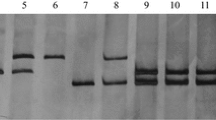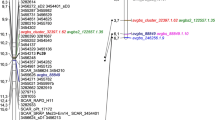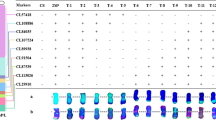Abstract
For the efficient introgression of the downy mildew resistance gene from a resistant cultivar into domestic breeding lines, molecular markers used for marker-assisted backcrossing (MAB) were developed in onion (Allium cepa L.). The resistance gene was originally introgressed from the wild species Allium roylei using interspecific hybridization, and the resistant gene was known to be positioned at the end of chromosome 3. Therefore, the cDNA sequences of the loci located at the ends of chromosome 3 of two linkage maps were obtained from a transcriptome database. Primer pairs were designed on the exon sequences of eight loci; among them, the PCR products of the i25255 locus showed length polymorphism between the A. roylei and onions, and both large- and small-sized PCR products were observed in the resistant cultivar. A sequence analysis showed that a 67-bp indel existed in the intron sequences. Based on this indel polymorphism, a simple PCR marker, designated “DMR1”, was developed. An analysis of diverse onion accessions showed that, with the exception of the resistant cultivar, none of the accessions contained the A. roylei-specific marker genotype. These results indicate that the DMR1 marker was successfully tagging the A. roylei fragment harboring the downy mildew resistance gene. After further analysis of multiple loci positioned at chromosome 3, a range of the A. roylei fragment introgressed in the resistant cultivar was determined in two linkage maps. On the basis of the range of the A. roylei fragment, three molecular markers used for recombinant selection in MAB were also developed.



Similar content being viewed by others
References
Battilani P, Rossi V, Racca P, Giosue S (1996) ONIMIL, a forecaster for primary infection of downy mildew of onion. Bull OEPP/EPPO 26:567–576
Brewster JL (2008) Onions and other vegetable Alliums, 2nd edn. CAB International, Wallingford, pp 79–83
de Visser CLM (1998) Development of a downy mildew advisory model based on DOWNCAST. Eur J Plant Pathol 104:933–943
de Vries JN, Wietsma WA, Jongerius MC (1992) Linkage of downy mildew resistance genes Pd 1 and Pd 2 from Allium roylei Stearn in progeny of its interspecific hybrid with onion (A. cepa L.). Euphytica 64:131–137
Doyle JJ, Doyle JL (1987) A rapid DNA isolation procedure for small quantities of fresh leaf tissue. Phytochem Bull 19:11–15
Duangjit J, Bohanec B, Chan AP, Town CD, Havey MJ (2013) Transcriptome sequencing to produce SNP-based genetic maps of onion. Theor Appl Genet 126:2093–2101
Gilles T, Phelps K, Clarkson JP, Kennedy R (2004) Development of MILIONCAST, an improved model for predicting downy mildew sporulation on onions. Plant Dis 88:695–702
Hall TA (1999) BioEdit: a user-friendly biological sequence alignment editor and analysis program for Window 95/98/NT. Nucleic Acids Symp Ser 41:95–98
Hasan MM, Rafii MY, Ismail MR, Mahmood M, Alam MA, Rahim HA, Malek MA, Latif MA (2015) Introgression of blast resistance genes into the elite rice variety MR263 through marker-assisted backcrossing. J Sci Food Agric. doi:10.1002/jsfa.7222
Herzog E, Frisch M (2011) Selection strategies for marker-assisted backcrossing with high-throughput marker systems. Theor Appl Genet 123:251–260
Kik C, Buiteveld J, Verbeek WHJ (1997) Biotechnological aspects of Allium breeding. Acta Hortic 433:291–297
Kim S, Kim M, Kim Y, Yeom S, Cheong K, Kim K, Jeon J, Kim S, Kim D, Sohn S, Lee Y, Choi D (2015) Integrative structural annotation of de novo RNA-Seq provides an accurate reference gene set of the enormous genome of the onion (Allium cepa L.). DNA Res 22:19–27
King JJ, Bradeen JM, Bark O, McCallum JA, Havey MJ (1998) A low-density genetic map of onion reveals a role for tandem duplication in the evolution of an extremely large diploid genome. Theor Appl Genet 96:52–62
Kofoet A, Kik C, Wietsma WA, de Vries JN (1990) Inheritance of resistance to downy mildew (Peronospora destructor [Berk.] Casp.) from Allium roylei Stearn in the backcross Allium cepa L. X (A. roylei × A. cepa). Plant Breed 105:144–149
Martin WJ, McCallum J, Shigyo M, Jakse J, Kuhl JC, Yamane N, Pither-Joyce M, Gokce AF, Sink KC, Town CD, Havey MJ (2005) Genetic mapping of expressed sequences in onion and in silico comparisons with rice show scant colinearity. Mol Genet Genomics 274:197–204
McCallum J, Baldwin S, Shigyo M, Deng Y, van Heusden S, Pither-Joyce M, Kenel F (2012) AlliumMap-a comparative genomics resource for cultivated Allium vegetables. BMC Genomics 13:168
Neeraja C, Maghirang-Rodriguez R, Pamplona A, Heuer S, Collard BCY, Septiningsih EM, Vergara G, Sanchez D, Xu K, Ismail AM, Mackill DJ (2007) A marker-assisted backcross approach for developing submergence-tolerant rice cultivars. Theor Appl Genet 115:767–776
Ouyang S, Zhu W, Hamilton J, Lin H, Campbell M, Childs K, Thibaud-Nissen F, Malek RL, Lee Y, Zheng L, Orvis J, Haas B, Wortman J, Buell CR (2007) The TIGR rice genome annotation resource: improvements and new features. Nucleic Acids Res 35:D883–D887
Scholten OE, van Heusden AW, Khrustaleva LI, Burger-Meijer K, Mank RA, Antonise RGC, Harrewijn JL, Van Haecke W, Oost EH, Peters RJ, Kik C (2007) The long and winding road leading to the successful introgression of downy mildew resistance into onion. Euphytica 156:345–353
Schwartz HF, Mohan SK (2008) Compendium of onion and garlic diseases and pests, 2nd edn. APS Press, St Paul, pp 32–35
Septiningsih EM, Pamplona AM, Sanchez DL, Neeraja CN, Vergara GV, Heuer S, Ismail AM, Mackill DJ (2009) Development of submergence-tolerant rice cultivars: the Sub1 locus and beyond. Ann Bot 103:151–160
Taran B, Warkentin TD, Vandenberg A (2013) Fast track genetic improvement of ascochyta blight resistance and double podding in chickpea by marker-assisted backcrossing. Theor Appl Genet 126:1639–1647
van der Meer QP, de Vries JN (1990) An interspecific cross between Allium roylei Stearn and Allium cepa L., and its backcross to A. cepa. Euphytica 47:29–31
van Heusden AW, Shigyo M, Tashiro Y, Vrielink-van Ginkel R, Kik C (2000a) AFLP* linkage group assignment to the chromosome of Allium cepa L. via monosomic addition lines. Theor Appl Genet 100:480–486
van Heusden AW, van Ooijen JW, Vrielink-van Ginkel R, Verbeek WHJ, Wietsma WA, Kik C (2000b) A genetic map of an interspecific cross in Allium based on amplified fragment length polymorphism (AFLP™) markers. Theor Appl Genet 100:118–126
Voorrips RE (2002) MapChart: software for the graphical presentation of linkage maps and QTLs. J Hered 93:77–78
Yarwood CE (1943) Onion downy mildew. Hilgardia 14:595–691
Acknowledgments
This research was supported by the Agriculture Research Center program, Golden Seed Project (Center for Horticultural Seed Development, No 213008-04-3-SB910) and a grant from the Next-Generation BioGreen 21 Program (Plant Molecular Breeding Center No. PJ011034). The authors thank Ji-wha Hur, Jeong-Ahn Yoo, and Su-jung Kim for their dedicated technical assistance.
Author information
Authors and Affiliations
Corresponding author
Electronic supplementary material
Below is the link to the electronic supplementary material.
Supplementary Fig. 1
Alignment of sequences of A. roylei and H6 alleles. a i33232 locus. b i35214 locus. The polymorphic sequences recognized by the restriction enzyme (Msp I) which were used in CAPS marker genotyping are enclosed in the rectangular boxes. The horizontal arrows indicate the positions of the primers. Supplementary material 1 (TIFF 226 kb)
Supplementary Fig. 2
Alignment of sequences of ‘Santero’ and H6 alleles of the i30363 locus. The polymorphic sequences recognized by the restriction enzyme (Aci I) which were used in CAPS marker genotyping are enclosed in the rectangular boxes. The horizontal arrows indicate the positions of the primers. Supplementary material 2 (TIFF 122 kb)
Rights and permissions
About this article
Cite this article
Kim, S., Kim, CW., Choi, MS. et al. Development of a simple PCR marker tagging the Allium roylei fragment harboring resistance to downy mildew (Peronospora destructor) in onion (Allium cepa L.). Euphytica 208, 561–569 (2016). https://doi.org/10.1007/s10681-015-1601-2
Received:
Accepted:
Published:
Issue Date:
DOI: https://doi.org/10.1007/s10681-015-1601-2




